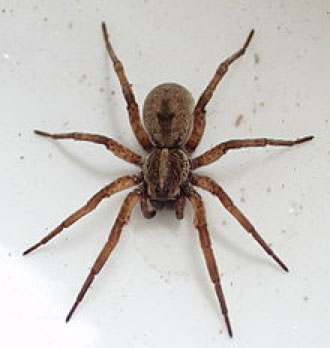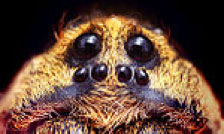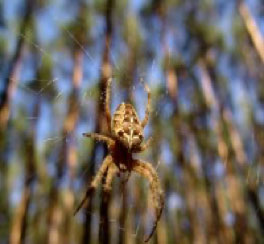Wolf Spider
Virtual Workshop
Oct 30 - Nov 1, 2020
KEYNOTE:
Pursue Opportunities
Digest past experiences
Protect your creative endeavors

Questions
- Are we not truly digesting our experiences (making meaning with heart & feeling)?
- Are we chewing on things of the past too long (procrastinating) or too much (mulling over), without getting any benefit (insight or results)?
- am I afraid to see that is directly in front of me (shaded perceptions)?
- Am I taking advantage of opportunities right in front of me?
- Am I protecting my creative ideas until fully manifested or giving them away to others including dreams?
Wolf spiders are members of the family Lycosidae, from the Ancient Greek word "λύκος" meaning "wolf". They are robust and agile hunters with excellent eyesight. They live mostly in solitude and hunt alone, and do not spin webs. Some are opportunistic hunters pouncing upon prey as they find it or even chasing it over short distances. Some wait for passing prey in or near the mouth of a burrow.
Wolf spiders resemble nursery web spiders (family Pisauridae), but wolf spiders carry their egg sacs by attaching them to their spinnerets, while the Pisauridae carry their egg sacs with their chelicerae and pedipalps. Two of the wolf spider's eight eyes are large and prominent, which distinguishes them from the nursery web spiders whose eyes are all roughly equal size. This can also help distinguish them from grass spiders.
 The many genera of wolf spiders range in body size (legs not included) from less than 10 to 35 mm (0.4 to 1.38 in). They have eight eyes arranged in three rows. The bottom row consists of four small eyes, the middle row has two very large eyes (which distinguishes them from the Pisauridae), and the top row has two medium-sized eyes. Unlike most other arachnids, which are generally blind or have poor vision, wolf spiders have excellent eyesight with their large eyes. The sensory hairs on their legs and bodies give them an acute sense of touch.
The many genera of wolf spiders range in body size (legs not included) from less than 10 to 35 mm (0.4 to 1.38 in). They have eight eyes arranged in three rows. The bottom row consists of four small eyes, the middle row has two very large eyes (which distinguishes them from the Pisauridae), and the top row has two medium-sized eyes. Unlike most other arachnids, which are generally blind or have poor vision, wolf spiders have excellent eyesight with their large eyes. The sensory hairs on their legs and bodies give them an acute sense of touch.
Flashing a beam of light over the spider produces eyeshine. The light from the flashlight has been reflected from the spider's eyes directly back toward its source, producing a "glow" that is easily noticed. Wolf spiders possess the third-best eyesight of all spider groups, bettered by jumping spiders of the family Salticidae (which can distinguish colors) and the huntsman spiders.
Wolf spiders are unique in the way that they carry their eggs. The egg sac, a round, silken globe, is attached to the spinnerets at the end of the abdomen, allowing the spider to carry her unborn young with her. The abdomen must be held in a raised position to keep the egg case from dragging on the ground. However, despite this handicap, they are still capable of hunting. Another aspect unique to wolf spiders is their method of care of young. Immediately after the spiderlings emerge from their protective silken case, they clamber up their mother's legs and crowd onto the dorsal side of her abdomen. The mother carries the spiderlings for several weeks before they are large enough to disperse and fend for themselves. No other spiders are currently known to carry their young on their backs for any period.
 Because they depend on camouflage for protection, they do not have the flashy appearance of some other kinds of spiders. In general, their coloration is appropriate to their favorite habitat.
Because they depend on camouflage for protection, they do not have the flashy appearance of some other kinds of spiders. In general, their coloration is appropriate to their favorite habitat.
Hogna is the genus with the largest of the wolf spiders. Among the Hogna species in the U.S., the nearly solid dark brown H. carolinensis (Carolina wolf spider) is the largest, with a body that can be more than 2.5 cm (1 in) long. It is sometimes confused with H. helluo, which is somewhat smaller and different in coloration. The underside of H. carolinensis is solid black, but the underside of H. helluo is variegated and has reds, oranges, and yellows with shades of black.
Some members of the Lycosidae, such as H. carolinensis, make deep, tubular burrows in which they lurk much of the time. Others, such as H. helluo, seek shelter under rocks and other shelters as nature may provide. They may wander from place to place, so are likely to be attracted into human habitation when the weather starts to turn colder in autumn. As with spiders in general, males of almost any species can sometimes be found inside homes and buildings as they wander in search for females during the autumn.
Many smaller genera of wolf spiders are found in Britain and Ireland. They live in pastures and fields and feed on smaller prey, playing an important role in natural population control that keeps insect numbers in the wolf spiders' vicinity within acceptable levels.
Venom
Wolf spiders inject venom if continually provoked. Symptoms of their bites include swelling, mild pain, and itching. In the past, necrotic bites have been attributed to some South American species, but further investigation has indicated that those problems that did occur were probably actually due to bites by members of other genera. Australian wolf spiders have also been associated with necrotic wounds, but careful study has likewise shown them not to produce such results.
We will Explore
We will learn how to use a looking deeper into our woven world and looking into our relationships to support ourselves.
Who Should Come?
The workshop is designed for people from all walks of life. It is focused towards expanding the awareness of spiritual explorers, healing, and shamanic practitioners, and the delightfully inquisitive.
What to Bring
This is at your home virtual workshop, so make yourself comfy. We will meditate, so, have any rocks or crystals that support your meditations. A journal notebook is encouraged.
Plan for Virtual
We will be virtual. So, if you have not done a virtual workshop, often called webinars, here’s some helpful information. Prior to our workshop:
- Go to https://Zoom.com and open a free account and install it on your computer. Make sure your computer has a camera. It is helpful but not needed that you have a headset with a microphone on it (like your cell phone headset). It cancels noise at home.
- Please watch at least the following how to videos using this link https://support.zoom.us/hc/en-us/articles/206618765-Zoom-Video-Tutorials. 1 minute video - Join a Meeting 3 minute video - Breakout Rooms
- Here is the zoom help center https://support.zoom.us/hc/en-us/categories/201137166
Details
The workshop will be done in four segments of 3, maybe 4 hours. With frequent breaks as you remind me of the need. The tentative schedule is as follows.
Friday 12-4 PM CST (1-5 PM EST)
Saturday 9-12 and 1-5 PM CST (10-1 and 2-6 PM EST)
Sunday 9-1 CST (10-2 EST)
Each segment will have a guided meditation, some teaching, an exercise and processing. This structure has worked well for me and shortly after we get comfortable, you will find that it can be and interesting and insightful experience.
The fee for the workshop is $295 as we want this affordable and we do not have normal expenses for when we are residential. Class size is limited to 21.
We will provide access to the recorded sessions the week following the workshop
Contact
For further information, kindly call Herb @ 440-338-1705 or email herb@onewhitehorsestanding.com
To reserve a space in the circle. Please send a check, payable to Herb Stevenson, 9796 Cedar Road, Novelty, Ohio 44072 or use PayPal link below.
We will limit attendees to 21.
Presenter: Herb "One White Horse Standing" Stevenson http://www.onewhitehorsestanding.com
Resources: Ted Andrews Animals Wise & Wikipedia

 Thoughts, A Beginning
Thoughts, A Beginning Thoughts II
Thoughts II Thoughts III: Creating the Container
Thoughts III: Creating the Container